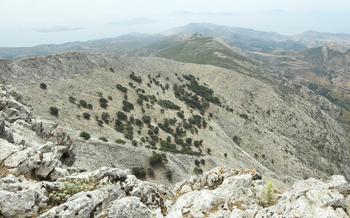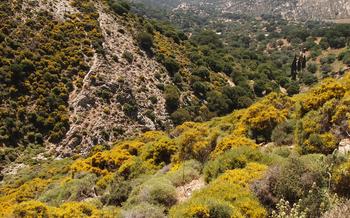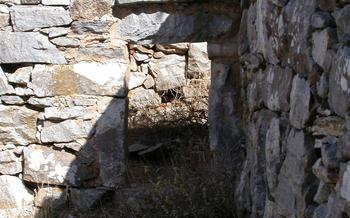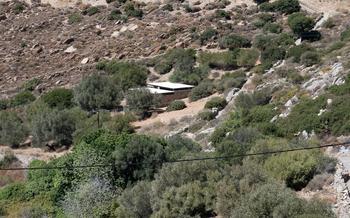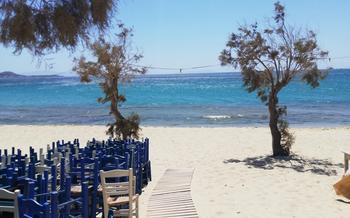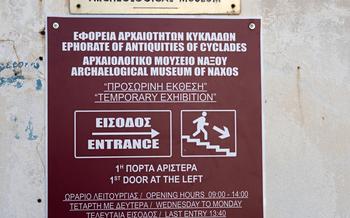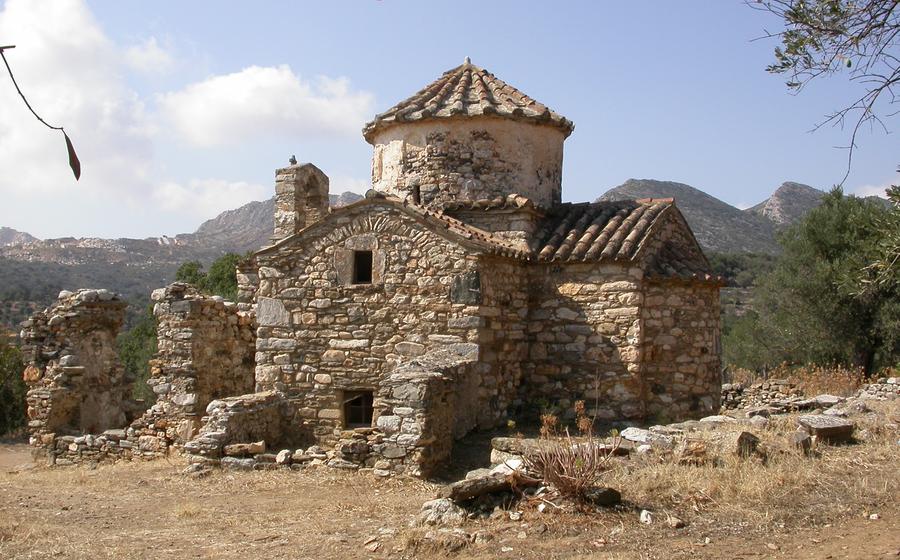
Saint Anna Church in Potamia
- The Church of Saint Anna in Potamia, Naxos
- The Village of Potamia
- Location and accessibility of the village
- History and cultural significance of Potamia
- What to see and do in the village
- Where to eat and stay in Potamia
- The Tragea Valley
- The Venetian Castle of Naxos
- The Temple of Apollo
- The Kouros of Naxos
- The Beaches of Naxos
- A Haven for Sunseekers, Swimmers, and Water Sports Enthusiasts
- The Naxian Cuisine
- The Naxos Festival
- A Celebration of Naxian Culture and History
- The Panagia Drosiani Church
- The Zas Cave
- The Mount Zas Hike
- Natural beauty and panoramic views
- Insider Tip
The Church of Saint Anna in Potamia, Naxos
History and architecture of the church
The Church of Saint Anna in Potamia, Naxos, is a beautiful and historic Byzantine church that dates back to the 11th century. It is one of the most important religious monuments on the island and is dedicated to the mother of the Virgin Mary. The church is built in a traditional Byzantine style, with a cross-in-square plan and a dome. The exterior of the church is decorated with blind arches and pilasters, while the interior is adorned with frescoes and mosaics.
Religious significance and local traditions
The Church of Saint Anna is a very important religious site for the people of Naxos. It is a place of pilgrimage and worship, and it is also a popular destination for weddings and other religious ceremonies. The church is also home to a number of important religious artifacts, including a relic of the True Cross.
Practical information for visiting the church
The Church of Saint Anna is located in the village of Potamia, which is about 10 kilometers from the city of Naxos. The church is open to visitors every day, and there is no admission fee. However, visitors should be aware that the church is a religious site, and they should be respectful of the people who are there to pray.
Personal anecdotes and experiences
I had the opportunity to visit the Church of Saint Anna in Potamia during my trip to Naxos. I was immediately struck by the beauty and serenity of the church. I spent some time exploring the interior of the church, and I was amazed by the frescoes and mosaics. I also took some time to sit in the courtyard of the church and enjoy the peace and quiet.
The Village of Potamia
Location and accessibility of the village
Potamia is a picturesque village located in the mountainous interior of Naxos, approximately 15 kilometers from the main port town of Naxos Town. The village is situated at an altitude of 350 meters, offering stunning panoramic views of the surrounding valleys and the Aegean Sea beyond. Potamia is easily accessible by car or bus, and there are regular bus services connecting the village to Naxos Town and other parts of the island.
History and cultural significance of Potamia
The history of Potamia can be traced back to the Byzantine era, and the village has a rich cultural heritage. During the Venetian rule, Potamia was an important agricultural and commercial center, and many of the village's traditional houses and churches date from this period. Potamia is also known for its traditional festivals and customs, and the village is home to several cultural associations that help to preserve and promote the local culture.
What to see and do in the village
In addition to the Church of Saint Anna, there are several other notable sights in Potamia. The village square is home to a beautiful 17th-century fountain, and there are several traditional tavernas and cafes where visitors can sample the local cuisine. The village also has a number of small shops and boutiques, selling everything from handmade souvenirs to local produce.
Where to eat and stay in Potamia
Potamia has a number of excellent tavernas and cafes, serving traditional Greek cuisine and local specialties. The village also has a few small hotels and guesthouses, offering comfortable accommodation for visitors. For a truly authentic experience, visitors can choose to stay in one of the village's traditional guesthouses, which are often family-run and offer a warm and welcoming atmosphere.
The Tragea Valley
The Tragea Valley, nestled in the heart of Naxos, unfolds a captivating tapestry of history, nature, and local traditions. Verdant landscapes, dotted with olive groves, vineyards, and citrus orchards, embrace meandering trails that beckon hikers and nature enthusiasts alike.
The valley's name, derived from the Greek word "tragos" meaning "goat," hints at the significance of goat farming in the region. Visitors can witness herds of goats grazing peacefully amidst the lush vegetation, a testament to the valley's pastoral heritage.
Beyond its agricultural charm, the Tragea Valley holds historical and mythological significance. Ancient ruins and remnants of Venetian fortifications whisper tales of bygone eras, while legends and myths intertwine with the valley's natural beauty.
For those seeking outdoor adventure, the Tragea Valley offers a wealth of opportunities. Hiking trails of varying difficulty levels traverse the valley, leading to hidden waterfalls, secluded beaches, and panoramic viewpoints. Mountain biking enthusiasts can embark on challenging trails that wind through the valley's rugged terrain.
The Tragea Valley is also renowned for its local products and traditional cuisine. Visitors can savor the flavors of freshly picked fruits, succulent olives and olive oil, and aromatic herbs. Local tavernas serve up delectable dishes prepared with seasonal ingredients, showcasing the bounty of the valley's harvest.
Whether seeking tranquility amidst nature, immersing oneself in history and mythology, or indulging in outdoor pursuits and culinary delights, the Tragea Valley promises an unforgettable experience for every traveler.
The Venetian Castle of Naxos
The Venetian Castle is an imposing medieval fortress that dominates the skyline of Naxos Town. It was built by the Venetians in the 13th century on the ruins of an earlier Byzantine fortress. The castle is a testament to the island's rich history and has been used for various purposes over the centuries, including as a military stronghold, a prison, and a residence for the Venetian governors.
Today, the castle is a popular tourist attraction and offers stunning views of the town and the surrounding countryside. Visitors can explore the castle's well-preserved ramparts, towers, and courtyards, and learn about its fascinating history. The castle also hosts cultural events and exhibitions throughout the year.
Practical Information:
- Location: The Venetian Castle is located on a hilltop in Naxos Town, just a short walk from the harbor.
- Opening Hours: The castle is open to the public daily from 8:00 am to 3:00 pm.
- Admission Fee: The entrance fee is €4 for adults and €2 for children.
- Accessibility: The castle is accessible by foot, but the climb to the top can be steep and challenging for some visitors.
Personal Anecdotes:
I visited the Venetian Castle on a sunny afternoon during my trip to Naxos. I was immediately impressed by its imposing size and the stunning views from the top. I spent several hours exploring the castle's many rooms and towers, and I learned a lot about its history from the informative signs and exhibits. I highly recommend visiting the Venetian Castle if you are interested in history and architecture.
The Temple of Apollo
The Temple of Apollo, located in the ancient city of Naxos, is one of the most iconic landmarks on the island. Constructed in the 6th century BC, the temple was dedicated to the Greek god Apollo, who was worshipped as the protector of Naxos. The temple was built using local marble and featured a grand facade with two rows of six Doric columns. The interior of the temple housed a colossal statue of Apollo, which was considered one of the most impressive works of ancient Greek sculpture.
Unfortunately, the temple was destroyed by an earthquake in the 3rd century AD, and only a few fragments of its once-magnificent structure remain today. These fragments, which include portions of the columns, pediments, and sculptures, are on display at the Archaeological Museum of Naxos.
Despite its ruined state, the Temple of Apollo still holds great significance for the people of Naxos. It is a reminder of the island's rich history and cultural heritage, and it continues to attract visitors from around the world who come to admire its grandeur and pay homage to the ancient Greek gods.
Practical Information for Visiting the Temple of Apollo
The Temple of Apollo is located in the ancient city of Naxos, a short walk from the harbor. The site is open to the public, and there is no admission fee. Visitors can explore the ruins of the temple and admire the remaining fragments of its once-magnificent structure.
Personal Anecdotes and Experiences
I had the opportunity to visit the Temple of Apollo during my trip to Naxos. I was immediately struck by the sheer size and grandeur of the ruins. Even though only a small portion of the temple remains, it was easy to imagine how impressive it must have been in its original state. I spent some time wandering around the site, examining the fragments of columns and sculptures. It was a fascinating experience to be able to connect with the past and to learn more about the history and culture of Naxos.
The Kouros of Naxos
The Kouros of Naxos is one of the most iconic and impressive ancient Greek sculptures in the world. It is a colossal marble statue of a young man, standing over 10 feet tall, that was carved around 580 BC. The kouros was discovered in 1864 on the island of Naxos, and it is now on display in the Archaeological Museum of Naxos.
The Kouros of Naxos is a masterpiece of archaic Greek sculpture. It is characterized by its simple, yet powerful and elegant forms, and its serene and dignified expression. The statue is also remarkable for its technical skill, as it is carved from a single block of marble with no visible seams or joins.
The Kouros of Naxos is thought to represent a young athlete or warrior, as it is depicted with a short tunic and a belt, and its hair is tied back in a ponytail. The statue's exact purpose is unknown, but it may have been commissioned as a votive offering to a god, or as a grave marker.
The Kouros of Naxos is a symbol of the transition from the Archaic to the Classical period in Greek sculpture. It shows the increasing naturalism and realism of the Classical style, while still retaining the simplicity and symmetry of the Archaic style. The kouros is a testament to the skill and artistry of the ancient Greek sculptors, and it is one of the most important works of art in the world.
The Beaches of Naxos
A Haven for Sunseekers, Swimmers, and Water Sports Enthusiasts
The stunning beaches of Naxos are one of the main reasons why the island attracts so many visitors each year. With its crystal-clear waters, golden sands, and dramatic cliffs, Naxos offers a diverse range of beaches to suit every taste.
For those seeking lively and well-organized beaches, Agios Prokopios and Plaka are excellent choices. These popular beaches offer a range of water sports facilities, sunbeds, and umbrellas for rent, as well as several restaurants and bars.
For a more secluded experience, head to one of the island's hidden beaches, such as Mikri Vigla or Kastraki. These beaches are often less crowded and offer stunning views of the surrounding landscape.
Whether you're looking to swim, sunbathe, or try your hand at water sports, Naxos has a beach to suit your needs. Be sure to bring your swimsuit and sunscreen, and prepare to be amazed by the beauty of Naxos's beaches.
The Naxian Cuisine
The Naxian cuisine is a delicious and diverse blend of flavors that reflects the history and culture of the island. With its rich soil and ample sunshine, Naxos has an abundance of fresh ingredients, including fruits, vegetables, and herbs, which are used to create a variety of traditional dishes.
One of the most famous Naxian dishes is the Naxos potato, a large and starchy potato that is grown in the fertile Tragea Valley. Naxos potatoes are often used in stews and casseroles, or simply boiled and served with olive oil and lemon juice.
Another Naxian specialty is kitron liqueur, a sweet and fragrant liqueur made from the citron fruit. Kitron is often served as an aperitif or digestif, and it can also be used in cocktails.
Naxos is also known for its cheese, which is produced from sheep's or goat's milk. The most popular Naxian cheese is graviera, a hard and salty cheese that is often used in cooking.
No visit to Naxos is complete without trying the local wine. Naxos has a long tradition of winemaking, and its wines are known for their fruity and flavorful taste. The most popular Naxian wines are the white Assyrtiko and the red Mandilaria.
If you are looking for a truly authentic Naxian meal, I recommend visiting one of the many traditional tavernas in the villages. These tavernas often serve family-style meals, which are a great way to sample a variety of Naxian dishes.
Personal Anecdote:
One of my favorite Naxian dishes is moussaka, a traditional Greek dish made with eggplant, potatoes, ground beef, and béchamel sauce. I first tried moussaka at a taverna in the village of Filoti, and I was immediately hooked. The eggplant was tender and flavorful, the potatoes were creamy and smooth, and the béchamel sauce was rich and decadent. I have since tried moussaka at many other restaurants in Naxos, but the one at the taverna in Filoti is still my favorite.
The Naxos Festival
A Celebration of Naxian Culture and History
The Naxos Festival is an annual event held in Naxos Town, attracting visitors from all over Greece and beyond. The festival celebrates the island's rich culture, history, and traditions through various events and activities. With music, dance, food, and exhibitions, the Naxos Festival offers a vibrant and immersive experience for all.
The festival's origins can be traced back to the ancient Greek festivals that honored Dionysus, the god of wine and fertility. Over the centuries, the festival evolved, incorporating elements of Christian tradition and local customs. Today, the Naxos Festival is a unique blend of ancient and modern, sacred and secular.
During the festival, the streets of Naxos Town come alive with music and dance. Traditional Greek musicians and dancers perform in the main square, while local bands and DJs play contemporary music in bars and clubs. There are also exhibitions of local art and crafts, food stalls offering traditional Naxian dishes, and plenty of opportunities to socialize and celebrate.
One of the highlights of the Naxos Festival is the re-enactment of the ancient Dionysian procession. Participants dressed in traditional costumes parade through the streets, carrying offerings to Dionysus and singing hymns in his honor. The procession culminates in a symbolic sacrifice, followed by a feast and dancing.
The Naxos Festival is a wonderful opportunity to experience the vibrant culture and traditions of Naxos. Whether you're interested in history, music, dance, food, or simply having a good time, the festival has something to offer everyone.
The Panagia Drosiani Church
A Historic Byzantine Church with Exquisite Mosaics
Located in the picturesque village of Moni, the Panagia Drosiani Church is one of the most important Byzantine churches in Greece. Built in the 6th century AD, it is renowned for its exquisite mosaics, which depict scenes from the Bible and the lives of saints. The church's interior is adorned with vibrant colors and intricate gold leaf work, creating a truly awe-inspiring atmosphere.
The Panagia Drosiani Church has a rich history, having survived numerous invasions and natural disasters throughout the centuries. It is believed that the church was originally built on the site of an ancient temple dedicated to the goddess Artemis. Over the years, it has been expanded and renovated, with the addition of new chapels and frescoes.
For those interested in Byzantine art and history, the Panagia Drosiani Church is a must-visit. Visitors can admire the stunning mosaics, marvel at the intricate architecture, and learn about the church's fascinating past. Guided tours are available, providing insights into the symbolism and significance of the artwork.
Insider Tip: Be sure to visit the church early in the morning or late in the afternoon to avoid the crowds and enjoy a more peaceful experience.
The Zas Cave
Location and accessibility of the cave
Zas Cave is located in the Tragea Valley of Naxos, about 15 kilometers from the village of Filoti, not far from the village of Apiranthos, on the road that leads to Chalki. To get to the cave, you can either drive or hike. The drive takes about 30 minutes, while the hike takes about 2 hours. The trailhead is located just outside the village of Apiranthos.
History and mythology of the cave
Zas Cave is one of the most important archaeological sites on Naxos. The cave was inhabited as early as the Neolithic period, and it was used as a place of worship in the Minoan and Mycenaean periods. In the classical period, the cave was dedicated to Zeus, the king of the gods. According to mythology, Zeus was born in a cave on Crete, but he was raised on Naxos. Zas Cave is believed to be the cave where Zeus was raised.
Practical information for visiting the cave
Zas Cave is open to the public from April to October. The cave is closed during the winter months due to the risk of flooding. The entrance fee is €Guided tours are available in English, Greek, and German. The tour lasts about 45 minutes.
Personal anecdotes and experiences
I visited Zas Cave in the summer of 202I was amazed by the size and beauty of the cave. The cave is full of stalactites and stalagmites, and the air is cool and damp. I could easily see why the cave was used as a place of worship in ancient times. I would highly recommend visiting Zas Cave if you are interested in history, mythology, or nature.
The Mount Zas Hike
Natural beauty and panoramic views
The Mount Zas hike is not only a challenging physical endeavor but also a journey through breathtaking natural beauty. The trail winds through lush forests, past cascading waterfalls, and offers panoramic views of the entire island and the surrounding Aegean Sea. As you ascend, the landscape transforms from verdant greenery to rugged, rocky terrain, providing a diverse and visually stunning experience.
The summit of Mount Zas, the highest point on the island, is a true spectacle. Here, you'll be rewarded with unparalleled 360-degree views that encompass the entire island, neighboring islands, and the vast expanse of the Aegean Sea. On a clear day, you can even spot the distant outline of Mount Olympus, the mythical home of the Greek gods.
Insider Tip
The best time to visit Naxos is undoubtedly during the shoulder seasons of spring and autumn when the weather is pleasant and the crowds are smaller. You'll have the chance to explore the island's many attractions without the summer rush and enjoy the warm hospitality of the locals.
To get around the island, the best option is to rent a car or a scooter. This will give you the freedom to explore at your own pace and discover hidden gems off the beaten path. Keep in mind that the roads can be narrow and winding, so drive carefully.
Naxos is a treasure trove of hidden gems waiting to be discovered. Be sure to venture beyond the main tourist spots and explore the island's charming villages, secluded beaches, and traditional tavernas. Ask the locals for recommendations, and they'll be happy to share their favorite spots with you.
I stumbled upon a hidden gem during my stay in Naxos: a small, picturesque cove with crystal-clear waters and hardly any tourists. It was the perfect place to escape the crowds and relax in the tranquil surroundings. Remember to explore and discover the island's hidden treasures.
